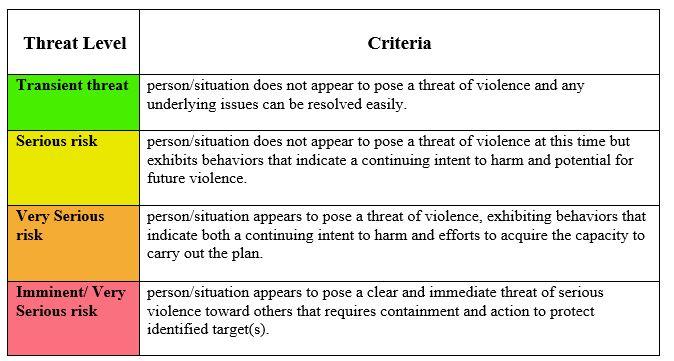August 2023
Dear Parents/Guardians,
The Novato Unified School District is committed to ensuring a safe community. NUSD believes all members of our community have the right to feel safe and protected, and we will respond to all student behavior that poses a potential risk to other students, staff and/or members of the community.
In extreme cases when a child’s behavior poses a potential threat to their own or others’ well-being, the NUSD Student Threat Assessment Team (STAT) will be convened to investigate and take further steps to safeguard everyone. The School Board has a policy BP/AR 0450 in place to support this manner of investigation. This letter serves as notification about this process.
Threat and risk assessment is the framework for a systematic response to threatening behaviors in schools and in the community. Certain behaviors may require a heightened response beyond NUSD’s progressive discipline process. The general purpose of a STAT assessment is to assist in creating and maintaining an environment where students, staff, parents/guardians and other feel safe by reducing risk and by assist the student to receive the help needed, and to address the issues contributing to the high-risk behavior. The STAT members include NUSD administration, counseling and teachers, as well as representatives from community agencies who work with us to keep our schools and community safe. Student Resource Officers (SROs) are involved when appropriate.
Parents and guardians will be notified if their child will be discussed through the Student Threat Assessment Team protocol. If parents/guardians cannot be reached, or if they choose not to provide consent, but a concern for safety still exists due to threatening behavior, the threat assessment may still proceed. Personal information shared throughout this process will respect and balance each individual’s right to privacy with the need to ensure the safety of all.
As always, a child’s safety is our first priority. If you have any questions regarding the NUSD Student Threat Assessment Team protocol, please speak with your student’s principal.
Sincerely,
Dr. Tracy Smith, Superintendent
CSBA: http://www.csba.org
California Department of Education, Safe Schools: http://www.cde.ca.gov/ls/ss
California Governor’s Office of Emergency Services: http://www.caloes.ca.gov
California Healthy Kids Survey: http://chks.wested.org
Centers for Disease Control and Prevention: http://www.cdc.gov/ViolencePrevention
Federal Bureau of Investigation: http://www.fbi.gov
National Center for Crisis Management: http://www.schoolcrisisresponse.com
National School Safety Center: http://www.schoolsafety.us
U.S. Department of Education: http://www.ed.govU.S. Secret Service, National Threat Assessment Center: http://www.secretservice.gov/ntac_ssi.shtml
Classifying Threats to Determine Response Strategies:
The threat inquiry is designed to identify and calculate risks in a deliberate and thorough manner. In determining response strategies to mitigate the risk and to provide assistance, as needed, it is helpful to classify threats by level. Based on the information collected, the threat inquiry team may classify threats using the following basic criteria:


OVERVIEW OF THE FIVE STEPS IN STUDENT THREAT INQUIRY
Step 1. Evaluate the threat. The principal investigates a reported threat by interview the student who made the threat and any witnesses to the threat. The principal considers the context and meaning of the threat, which are important than the literal content of the threat.
Step 2. Decide whether the threat is transient or substantive. A transient threat is not a serious threat and can be easily resolved, but substantive threat raises concern of potential injury to others. For transient threats, go to step 3 and for substantive threats, skip to step 4.
Step 3A. Respond to a transient threat/low risk. If the threat is a transient threat, the principal may respond with a reprimand, parent notification, or other actions that are appropriate to the severity and chronicity of the situation. The incident is resolved and no further action is needed.
OR Step 3B. Decide whether the substantive threat is serious or very serious. If a threat is substantive the principal must decide how serious the threat is and take appropriate action to protect potential victims. A threat to hit, assault or beat up someone is serious, whereas a threat to kill, rape, use a weapon on or severely insure someone is considered very serious. For serious threats, go to Step 5 and for very serious threats skip to Step 6.
Step 4A. Respond to serious substantive threat/moderate risk. A serious substantive threat requires proactive, protective action to prevent violence, including notification of potential victims and other actions to address the conflict or problem that generated the threat. The response to a serious substantive threat is completed at this step.
OR Step 4B. Respond to a very serious substantive threat/high or imminent risk (conduct a safety evaluation). A very serious substantive threat requires immediate protective action, including contact with law enforcement, followed by a comprehensive safety evaluation. The student is suspended from school pending completion of the safety evaluation, which includes a mental health assessment to determine referral and support needs.
Step 5. Implement a safety plan. The threat assessment team develops and implements a plan that is designed both to protect potential victims and to meet the student’s educational needs. The plan includes a provision for monitoring the student and revising the plan as needed.
Adapted from Guidelines for Responding to Student Threats of Violence, Dewy G. Cornell & Peter L. Sheras (Sopris West, 2006)

